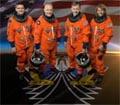 Orbiter: Atlantis Mission: STS-135 Payload: Raffaello Launch: July 8, 2011 Time: 11:26 a.m. EDT Site: Pad 39A, Kennedy Space Center Landing: July 20 @ approx. 7:06 a.m. EDT Site: KSC's Shuttle Landing Facility  
|
Mission Status CenterLive coverage of space shuttle Atlantis' STS-135 mission to the International Space Station. Text updates will appear automatically; there is no need to reload the page. Follow us on Twitter. THURSDAY, JUNE 16, 2011
Between the fueling test and the payload delivery, the rotating service structure at pad 39A will remain retracted away from space shuttle Atlantis for several days this week.
2100 GMT (5:00 p.m. EDT) The gantry features a payload changeout room and the equipment to insert the mission hardware into Atlantis' cargo bay. After the payload canister reaches the pad around 11:30 p.m. EDT tonight, it will be hoisted into the tower overnight and the contents unloaded into the cleanroom tomorrow. The canister then lowers away and the gantry placed back around the orbiter on Saturday to transfer the payloads to Atlantis on Monday. 1400 GMT (10:00 a.m. EDT)
The residual amounts of hydrogen in the bottom of Atlantis' external tank will be boiled away by noontime today, allowing the launch pad to reopen for normal work following yesterday's fueling exercise.
The 60-foot-long canister holding the mission payloads is awaiting the all-clear in preparation for tonight's drive from Kennedy Space Center's industrial area to pad 39A. The trip is scheduled to begin around 9 p.m. EDT. Lifting of the container up into the pad's gantry is expected to start a little after midnight. Meanwhile, technicians will be working to gain access into the orbiter's aft compartment to begin examining the main fuel valve on space shuttle main engine No. 3 -- the bottom-right engine. The launch team detected temperatures well below normal levels during fueling yesterday, indicating a leak from that valve. For now, officials are optimistic that replacing the valve could be accomplished without delaying the July 8 launch date. WEDNESDAY, JUNE 15, 2011
Engineers pumped a half-million gallons of supercold rocket fuel into the shuttle Atlantis' external tank Wednesday to verify the integrity of structural stiffeners intended to prevent cracks during the countdown and climb to space July 8. During the operation, however, the launch team detected indications of a possible leak on engine No. 3's main fuel valve.
Read our full story. 2145 GMT (5:45 p.m. EDT)
This day-and-a-half countdown sequence to fuel the space shuttle Atlantis and collect data about the external tank's performance during cryogenic conditions has run its course. The launch team has moved into standard safing procedures and draining the liquid oxygen and liquid hydrogen from the tank.
The mission payloads are scheduled for delivery to the launch pad Thursday night. They will be hoisted into the gantry early Friday and unloaded into the cleanroom for Monday's planned installation into Atlantis' cargo bay. The engine No. 3 leak discovered during today's fueling also will be a topic to watch in the coming days. 2030 GMT (4:30 p.m. EDT)
This type of fueling test is a rarity for the space shuttle. Over the history of the program, officials have sparingly ordered shuttles be loaded with cryogenics to check for leaks or examine the performance of hardware.
NASA has conducted about a dozen special fueling tests in the past three decades beginning with the very first mission, STS-1, back in 1981. The first flight after the Challenger accident, STS-26, also underwent a fueling exercise in 1988. The pair of missions plagued by hydrogen leaks -- STS-35 and STS-38 -- had six special tanking tests to troubleshoot the problems and later verify the issues were fixed in 1990. STS-91 debuted the new external tank design and had a pre-flight checkout with the cryogenics loaded aboard in 1998. The first flight after the Columbia accident, STS-114, had two fueling tests in 2005. STS-127 was fueled to ensure repairs to the gaseous hydrogen umbilical were successful. And a test like today's occurred last December to experiment with Discovery's cracked tank. 1935 GMT (3:35 p.m. EDT)
The external fuel tank has been placed in stable replenish, completing the three-hour loading process for space shuttle Atlantis. But today's test is not done. The shuttle will sit here for two-and-a-half-hours with the tank topped off in a cryogenic state before the launch team begins to drain the liquid oxygen and liquid hydrogen from the external tank.
1914 GMT (3:14 p.m. EDT)
T-minus 3 hours and holding. Clocks have gone into the planned hold following fueling. The countdown is not scheduled to move beyond this point for today's test.
1835 GMT (2:35 p.m. EDT)
An apparent leak has occurred on the fuel valve for space shuttle main engine No 3. The launch team has been able to slow the leakage and allow the tanking test to continue today. But obviously the valve problem will have to be addressed before Atlantis can launch.
Meanwhile, the liquid hydrogen tank reached the 98 percent level and transitioned to topping mode. No problems have been reported with the ground umbilical carrier plate hardware on the backside of the external fuel tank. It's at this point of topping that previous leaks have been detected. 1745 GMT (1:45 p.m. EDT)
Just over the 90-minute mark in today's fueling.
The cryogenics flow from storage spheres at the pad, through feed lines to the mobile launcher platform, into Atlantis' aft compartment and finally into the external fuel tank. 1725 GMT (1:25 p.m. EDT)
There are two tanks inside the shuttle's external fuel tank. The liquid oxygen tank occupies the top third of the bullet-shaped tank. It will be filled with 143,000 gallons of liquid oxygen chilled to minus 298 degrees Fahrenheit. The liquid hydrogen tank is contained in the bottom two-thirds of the external tank. It holds 385,000 gallons of liquid hydrogen chilled to minus 423 degrees Fahrenheit.
1655 GMT (12:55 p.m. EDT)
The fueling sequence started with the chilldown of the liquid oxygen system at 12:15 p.m. EDT. The transfer lines on the liquid oxygen side get chilled down, then the main propulsion system conditioning is completed.
The liquid hydrogen loading transitioned from the chilldown thermal conditioning process to the "slow-fill" mode a short time later. This fills a small fraction of the tank, then the loading switches to "fast-fill" mode. 1635 GMT (12:35 p.m. EDT)
FUELING UNDERWAY. Filling of space shuttle Atlantis with supercold liquid hydrogen and liquid oxygen rocket fuel has started for this confidence-building test on the external fuel tank's performance under cryogenic conditions.
The test will put the tank through the experiences and stresses of fueling to ensure the strengthened ribbed midsection does not crack or exhibit any problems. The area will be digitally X-rayed in the coming days to formally clear Atlantis for launch next month. 1515 GMT (11:15 a.m. EDT)
The Mission Management Team met for the pre-fueling meeting and granted approval to load a half-million gallons of supercold rocket fuel into Atlantis' external tank later today. Technicians are continuing to catch up for yesterday's weather-related delays and a partial power out that occurred at the launch pad. But the fueling start time has slipped awhile approximately 12:30 p.m.
1315 GMT (9:15 a.m. EDT)
Thunderstorms pounded the Kennedy Space Center overnight Tuesday and at least three lightning strikes were recorded near launch pad 39A where the shuttle Atlantis is poised for liftoff July 8. There were no obvious signs of trouble with the shuttle's electrical systems, but a planned fueling test to check the performance of structural stiffeners in Atlantis' external tank, originally scheduled to begin at 7 a.m. EDT (GMT-4), has been held up to give engineers time to complete storm-related troubleshooting.
Read our full story. 0700 GMT (3:00 a.m. EDT)
The space shuttle Atlantis has been unveiled from the cocoon-like service gantry at Kennedy Space Center's pad 39A.
Technicians will spend the next few hours getting ground equipment configured and secured in preparation for today's fueling with supercold rocket propellant. Inside Atlantis' cockpit, meanwhile, support personnel will verify switches are in the correct positions for the test. Clocks resumed counting at 1 a.m. EDT after the hold at T-minus 11 hours. The next planned hold is T-minus 6 hours beginning at 6 a.m. EDT. Loading of the external tank with propellant is anticipated to start at 11 a.m. EDT. The process should take three hours to complete. No coverage on NASA TV or commentary is planned for the event. But join us here in the Mission Status Center for live streaming video and updates as information becomes available. A reminder that if you will be away from your computer but would like to receive occasional updates, sign up for our Twitter feed to get text messages on your cellphone. U.S. readers can also sign up from their phone by texting "follow spaceflightnow" to 40404. (Standard text messaging charges apply.) TUESDAY, JUNE 14, 2011
Severe weather that blew across Central Florida earlier today has delayed preparations for Wednesday's fueling test on space shuttle Atlantis.
Retraction of the protective gantry from around Atlantis originally planned for about 9:30 p.m. tonight has been retargeted for approximately 1 a.m. EDT (0500 GMT). An engineering review is planned for 8 a.m., followed the pre-fueling management team meeting at 10 a.m. and a weather briefing at 10:30 a.m. The start of fueling has been pushed back four hours -- from the scheduled 7 a.m. start time until 11 a.m. EDT. It will take three hours to fill load the tank and then the shuttle will sit in a fully loaded state for another two-and-a-half hours before the test concludes at approximately 4:30 p.m. EDT, under this revised game plan. MONDAY, JUNE 13, 2011
Inside Kennedy Space Center's launch control room, the countdown has begun ticking for Wednesday's unique test on space shuttle Atlantis' external fuel tank.
Teams gathered at 8:30 p.m. and started the clocks ticking at 9 p.m. EDT from the T-minus 33 hour mark. The next day-and-a-half will be spent readying the space shuttle and launch pad 39A for the fueling test. Pre-programmed holds are planned at various points in the countdown, ultimately leading to the start of fueling operations Wednesday at 7 a.m. EDT. The built-in holds are slated to occur at the T-minus 11 hour, T-minus 6 hour and T-minus 3 hour points. Atlantis will be loaded with 500,000 gallons of cryogenic liquid oxygen and liquid hydrogen for NASA's precautionary exercise to check the external tank's response to filling and draining the supercold propellants. Fueling should be completed around 10 a.m., then the shuttle will sit in a fully loaded state for two-and-half-hours before the cryos are offloaded and the countdown concludes at 12:30 p.m. Knowledge gained from the test and later inspections of the tank's midsection will verify modifications performed on the ribbed intertank section to beef up the structural integrity before Atlantis' real launch attempt on July 8. After several structural ribs cracked on shuttle Discovery's tank during fueling on the Nov. 5, that mission was delayed delayed a few months while engineers assessed what caused the problem and how to fix it. The exhaustive troubleshooting determined that a batch of material with low fracture toughness and pent up stresses accumulated during construction coupled to crack the ribs during the strains of cryogenic fueling. Stiffeners were installed over the support beams on Discovery's tank and the mission safely launched in February. Since Atlantis' tank shares the same pedigree as Discovery's tank, the repairs were performed on this vehicle too. Wednesday's fueling will put the tank through a full fueling to reveal any problems, although engineers expect no cracks or problems to occur. Afterwards, digital X-rays will be conducted to look at the ribbed midsection on the front of the tank facing the orbiter. WEDNESDAY, JUNE 8, 2011
For the final time in space shuttle program history, launch pad technicians have completed hypergolic servicing work on Atlantis. The last portion of the hazardous operation occurred today when the Auxiliary Power Units were serviced with their supplies of hydrazine.
The pad will be reopened tonight so closeouts of the orbiter's aft compartment and preps for next week's external fuel tank loading test can begin. TUESDAY, JUNE 7, 2011
The hazardous fuel loading continues on space shuttle Atlantis today as technicians load the orbiter's forward and aft reaction control system thruster tanks and engine pods with nitrogen tetroxide. The fuel loading will begin later this afternoon.
Technicians successfully completed the hydrazine filling for the solid rocket booster hydraulic power units yesterday as planned. MONDAY, JUNE 6, 2011
The multi-day task to load the storable hypergolics into the space shuttle vehicle began this morning at launch pad 39A. Today's work focuses on servicing the hydraulic power units on Atlantis' solid rocket boosters. The HPUs enable the motor's nozzles to swivel during ascent and steer the shuttle.
Meanwhile, the four astronauts are visiting Kennedy Space Center for a final up-close inspection inside Raffaello at the Space Station Processing Facility before the cargo module's hatch is sealed for launch. Commander Chris Ferguson and pilot Doug Hurley also plan some nighttime landing practice using Shuttle Training Aircraft at KSC's runway this evening. And the target launch and landing times for the mission have been tweaked by a few minutes based on the latest updates from Mission Control. Liftoff on July 8 is reset for 11:26 a.m. EDT (1526 GMT) and landing on July 20 aims for 7:06 a.m. EDT (1106 GMT). FRIDAY, JUNE 3, 2011
The space shuttle main engine and aerosurface flight readiness tests were successfully completed on Atlantis last night. The pre-launch leak check of the main propulsion system using helium will be performed on Saturday.
Among the other activities accomplished this week following arrival at the launch pad were the gaseous hydrogen vent arm and its ground umbilical carrier plate mating to the backside of the external tank. Waves of tankers have been replenishing the launch pad's cryogenic fuel storage spheres as well. Loading of hypergolics into the shuttle begins Monday. THURSDAY, JUNE 2, 2011
Hours after Atlantis was parked at pad 39A, Spaceflight Now received rare access to the shuttle launch complex as the sun rose over the Atlantic Ocean. These spectacular photos show the spaceship from all angles as it's readied for the last space shuttle launch in July.
See our photo special! 1430 GMT (10:30 a.m. EDT)
The service structure was rotated around shuttle Atlantis at launch pad 39A this morning following last night's APU confidence run. Pad validation testing is underway and the flight readiness checks on the main engines are upcoming.
0300 GMT (11:00 p.m. EDT Wed.)
Here's another photo gallery from last night showing Atlantis emerging from the Vehicle Assembly Building.
0030 GMT (8:30 p.m. EDT Wed.)
Atlantis is spending her first night at launch pad 39A to begin the final pre-launch campaign for the space shuttle program. The rotating service gantry remains open in preparation for this evening's planned hot-fire testing of the orbiter's three Auxiliary Power Units, which provide the hydraulic pressure to move the aerosurfaces, gimbal the main engines and perform other tasks during the ascent and landing phases of the mission. An APU hot-fire on all three units occurs when there has been a long gap between flights of a vehicle, in this case a full year since Atlantis last flew.
Read our earlier status center coverage. |
Upcoming mission events:
Space video for your computer, iPod or big screen TV
Experience the space program like never before become a subscriber today |


